CADILLAC SEVILLE 1993 4.G Owners Manual
Manufacturer: CADILLAC, Model Year: 1993, Model line: SEVILLE, Model: CADILLAC SEVILLE 1993 4.GPages: 407, PDF Size: 22.28 MB
Page 191 of 407
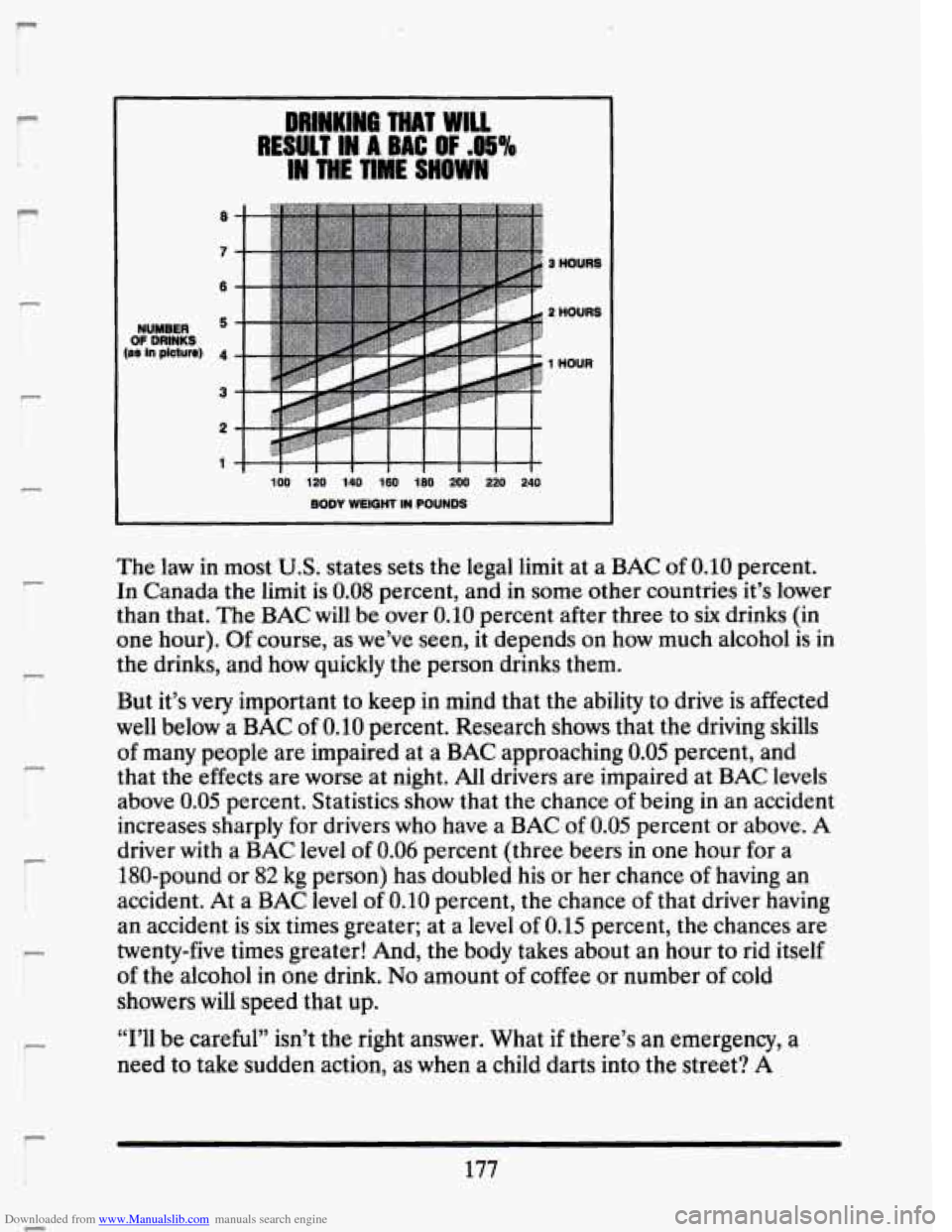
Downloaded from www.Manualslib.com manuals search engine 1.. I F
I-
F
r
I- !
r I L
P
r
r
r - -------la THAT WILL
R-- A BAC OF .85%
3 HOURS
2 HOURS
1 HOUR
I I I I I I 1 I f I I I I I I I
BODY WEIGHT IN POUNDS
100 120 140 160 180 200 220 240
The law in most US. states sets the legal limit at a BAC of 0.10 percent.
In Canada the limit
is 0.08 percent, and in some other countries it’s lower
than that. The BAC will be over 0.10 percent after three to
six drinks (in
one hour). Of course, as we’ve seen, it depends on how much alcohol is in
the drinks, and
how quickly the person drinks them.
But it’s very important
to keep in mind that the ability to drive is affected
well below
a BAC of 0.10 percent. Research shows that the driving skills
of many people are impaired at a BAC approaching 0.05 percent, and
that
the effects are worse at night. All drivers are impaired at BAC levels
above 0.05 percent. Statistics show that
the chance of being in an accident
increases sharply for drivers who have a BAC of 0.05 percent or above. A
driver
with a BAC level of 0.06 percent (three beers in one hour for a
180-pound or
82 kg person) has doubled his or her chance of having an
accident. At a BAC level of
0.10 percent, the chance of that driver having
an accident is
six times greater; at a level of 0.15 percent, the chances are
twenty-five times greater! And, the body takes about an hour to rid itself
of the alcohol
in one drink. No amount of coffee or number of cold
showers will speed that up.
“I’ll be careful” isn’t the right answer. What
if there’s an emergency, a
need to take sudden action, as when a child darts into the street? A
177
F
Page 192 of 407
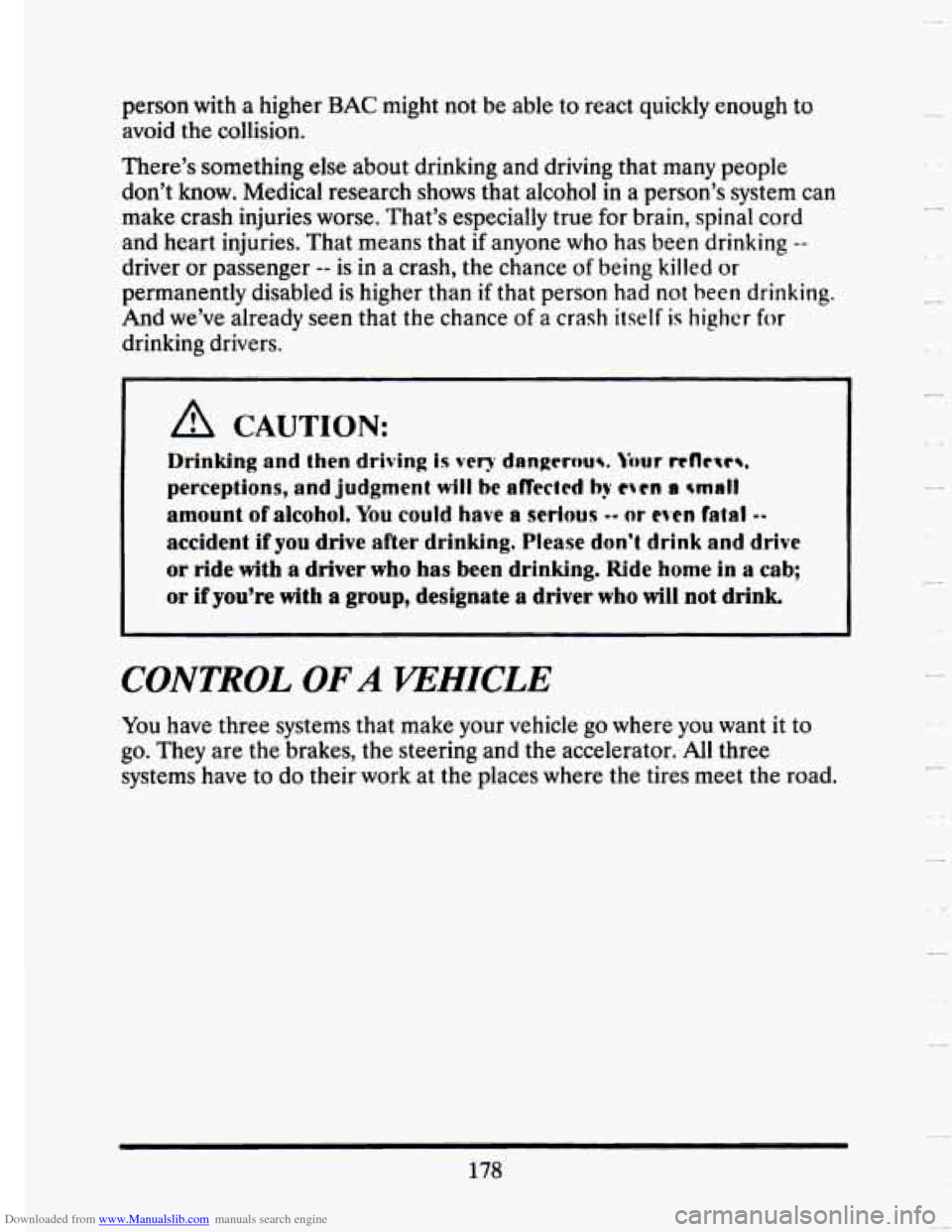
Downloaded from www.Manualslib.com manuals search engine person with a higher BAC might not be able to react quickly enough to
avoid the collision.
There’s something else about drinking and driving that many people
don’t know. Medical research shows that alcohol
in a person’s system can
make crash injuries worse. That’s especially true for brain, spinal cord
and heart injuries. That means that
if anyone who has been drinking --
driver or passenger -- is in a crash, the chance of being killed or
permanently disabled is higher than if that person had not been drinking.
And we’ve already seen that the chance of a crash itself is higher for
drinking drivers.
A CAUTION:
Drinking and then driving is very dangeroucr. hur rt(lrw%.
perceptions, and judgment will be aNecled by even a smrl?
amount of alcohol. You could have a serious -- or even fatal --
accident if you drive after drinking. Please don’t drink and drive
or ride with a driver who has been drinking. Ride home in a cab;
or if you’re with a group, designate a driver who will not drink.
CONTROL OF A PEHICLE
You have three systems that make your vehicle go where you want it to
go. They are the brakes, the steering and the accelerator. All three
systems have to do their work at
the places where the tires meet the road.
178
Page 193 of 407
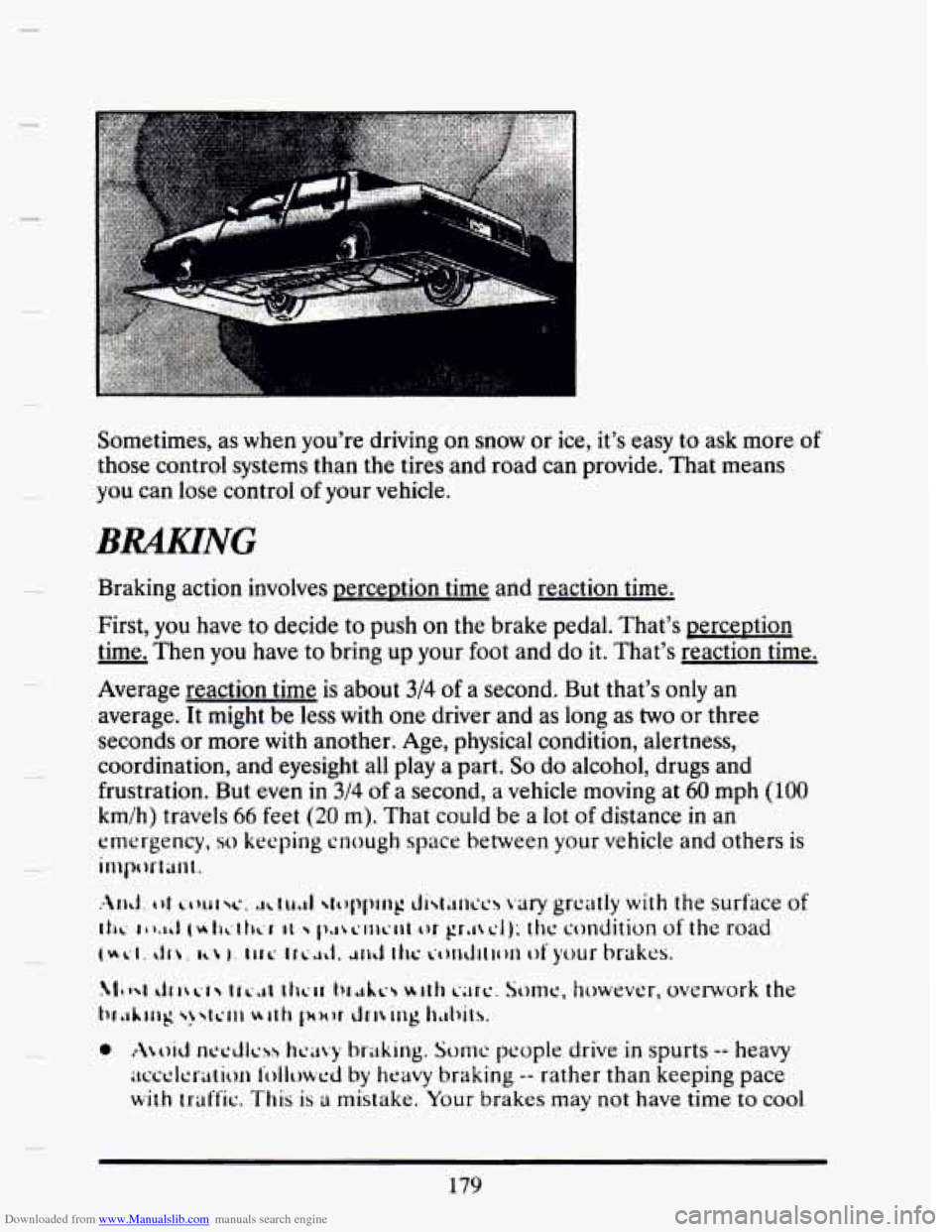
Downloaded from www.Manualslib.com manuals search engine Sometimes, as when you're driving on snow or ice, it's easy to ask more of
those control systems than the tires and road can provide. That means
you can lose control of your vehicle.
Braking action involves perceDtion time and reaction time.
First, you have to decide to push
on the brake pedal. That's perceDtion
- time. Then you have to bring up your foot and do it. That's reaction time.
Average reaction time is about
3/4 of a second. But that's only an
average. It might be less with one driver and
as long as two or three
seconds or more with another. Age, physical condition, alertness,
coordination, and eyesight
all play a part. So do alcohol, drugs and
frustration. But even in
3/4 of a second, a vehicle moving at 60 mph (100
km/h) travels 66 feet (20 m). That could be a lot of distance in an
emergency,
so keeping cnough space between your vehicle and others is
impclrtmt.
.hJ. ot LAWN*. .ILIU.II qqwg di\l,mccb vary grcatly with the surface of
IIK IO.^ (ut~ilt~k~l II pai~-ll~~*l~t or gr,t\cl); the condition of the road
(UL'I. dr?, ~i) ). IIIC 1rc.d. JI~ ttrc LX~~I~IOII of your brakes.
0 ALclid nccdlchs hca\y braking. Somc: people drive in spurts -- heavy
acceleration followed by heavy braking -- rather than keeping pace
with traffic. This is a mistake. Your brakes may not have time to cool
179
Page 194 of 407

Downloaded from www.Manualslib.com manuals search engine 3
between hard stops. Your brakes will wear out much faster if you do a
lot of heavy braking.
Don’t “ride” the brakes by letting your left foot rest lightly on the
brake pedal
while driving.
8
A CAUTION:
“Riding” your brakes can cause them to overheat to the point
that they won’t work well. You might not be able
to stop your
vehicle in time to avoid
an accident. If you “ride” your brakes,
they
will get so hot they will require a lot of pedal force to slow
you down. Avoid “riding” the brakes.
180
-4
Page 195 of 407
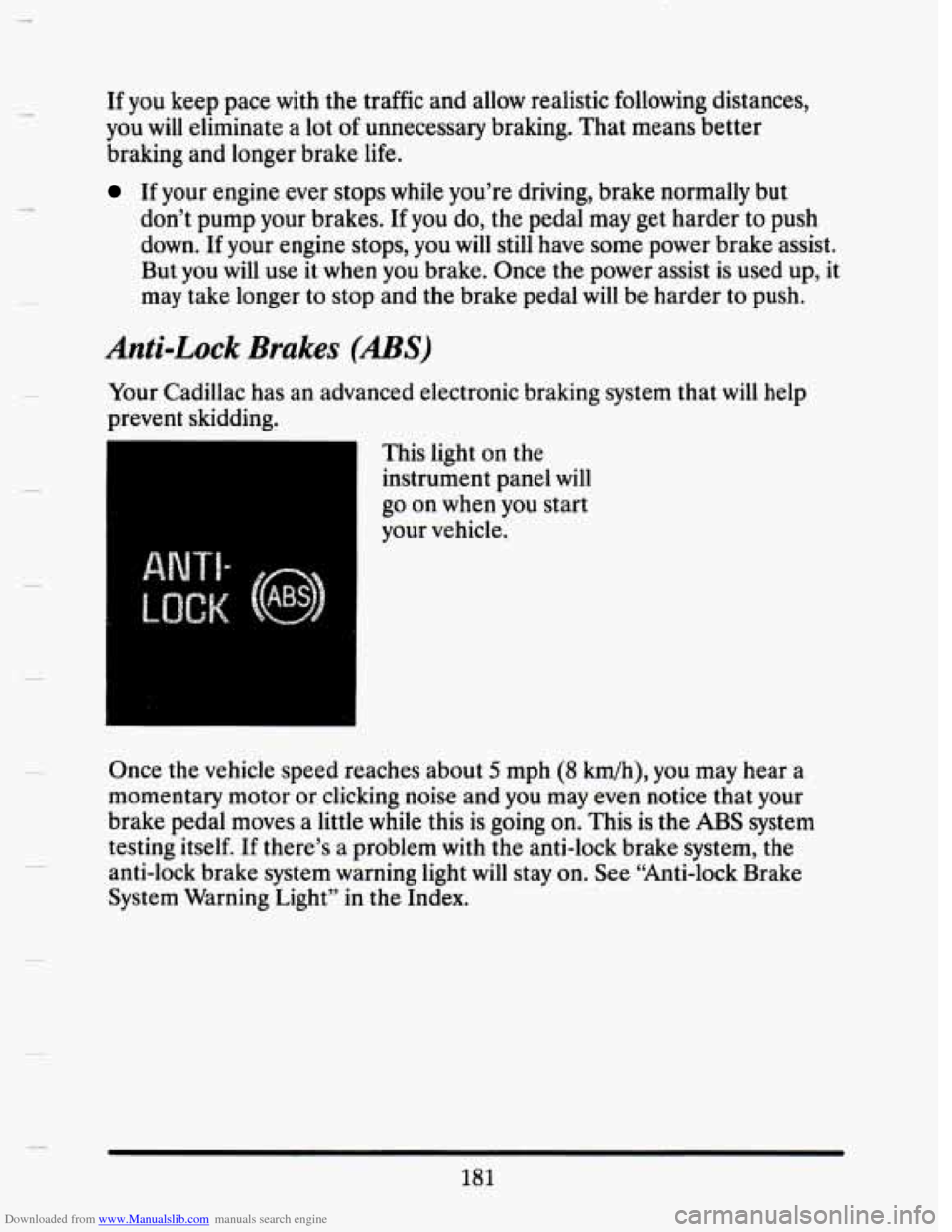
Downloaded from www.Manualslib.com manuals search engine If you keep pace with the traffic and allow realistic following distances,
you will eliminate a lot
of unnecessary braking. That means better
braking and longer brake
life.
If your engine ever stops while you’re driving, brake normally but
don’t pump your brakes. If you do,
the pedal may get harder to push
down.
If your engine stops, you will still have some power brake assist.
But you will use it when you brake. Once the power assist is used up, it
may take longer to stop and the brake pedal
will be harder to push.
Anti-Lock Brakes (ABS)
Your Cadillac has an advanced electronic braking system that will help
prevent skidding.
This light on the
instrument panel
will
go on when you start
your vehicle.
Once the vehicle speed reaches about
5 mph (8 krnh), you may hear a
momentary motor
or clicking noise and you may even notice that your
brake pedal moves a little
while this is going on. This is the ABS system
testing itself. If there’s a problem with the anti-lock brake system, the
anti-lock brake system warning light
will stay on. See “Anti-lock Brake
System Warning Light” in the Index.
181
Page 196 of 407
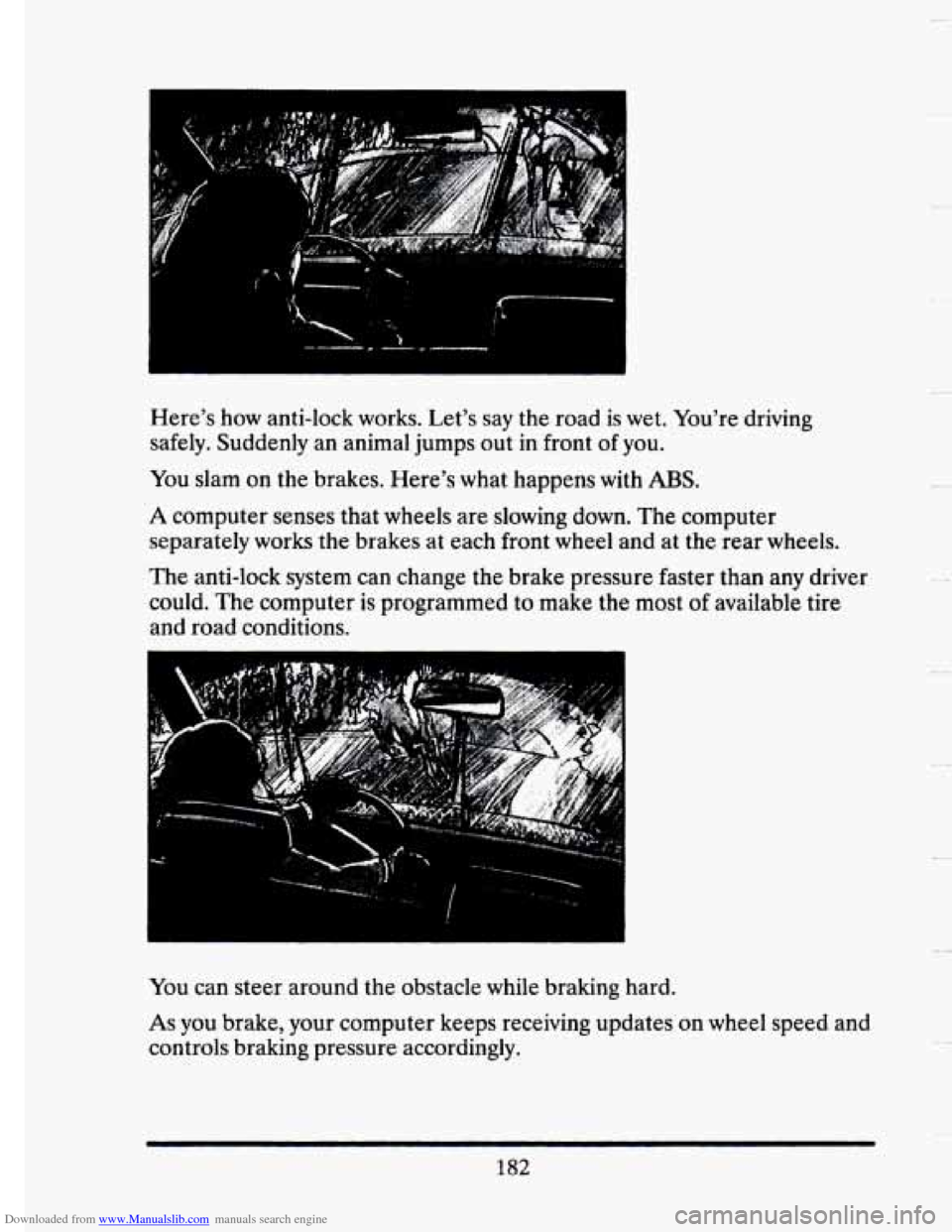
Downloaded from www.Manualslib.com manuals search engine Here’s how anti-lock works. Let’s say the road is wet. You’re driving
safely. Suddenly an animal jumps out in front of you.
You slam on the brakes. Here’s what happens with ABS.
A computer senses that wheels are slowing down. The computer
separately works
the brakes at each front wheel and at the rear wheels.
The anti-lock system can change the brake pressure faster than any driver
could. The computer is programmed to make the most
of available tire
and road conditions.
You can steer around the obstacle while braking hard.
As you brake, your computer keeps receiving updates on wheel speed and
controls braking pressure accordingly.
182
Page 197 of 407
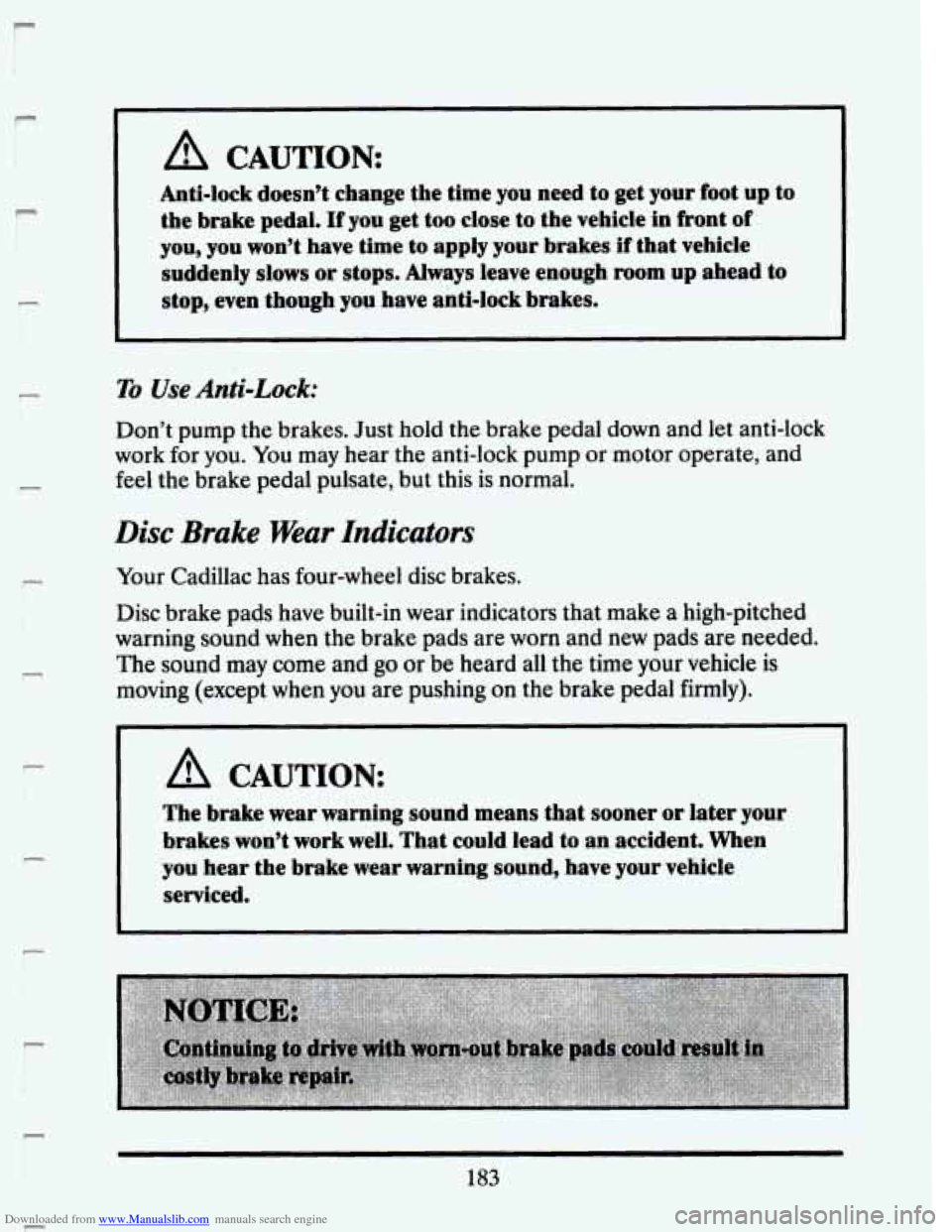
Downloaded from www.Manualslib.com manuals search engine P
P
c
P
F
F
A CAUTION
Anti-lock doesn’t change the time you need to get your foot up to
the brake pedal.
If you get too close to the vehicle in fkont of
you, you won’t have time to apply your brakes if that vehicle
suddenly slows
or stops. Always leave enough room up ahead to
stop, even though you have anti-lock brakes.
To Use Anti-Lock:
Don’t pump the brakes. Just hold the brake pedal down and let anti-lock
work for
you. You may hear the anti-lock pump or motor operate, and
feel the brake pedal pulsate, but this is normal.
Disc Brake Wear Indicators
Your Cadillac has four-wheel disc brakes.
Disc brake pads have built-in wear indicators that make a high-pitched
warning sound when the brake pads are worn and new pads are needed.
The
sound may come and go or be heard all the time your vehicle is
moving (except when you are pushing on the brake pedal firmly).
The brake wear warning sound means that sooner or later your
brakes won’t work well. That could lead
to an accident, When
you hear the brake wear warning sound, have your vehicle
serviced.
183
r
Page 198 of 407
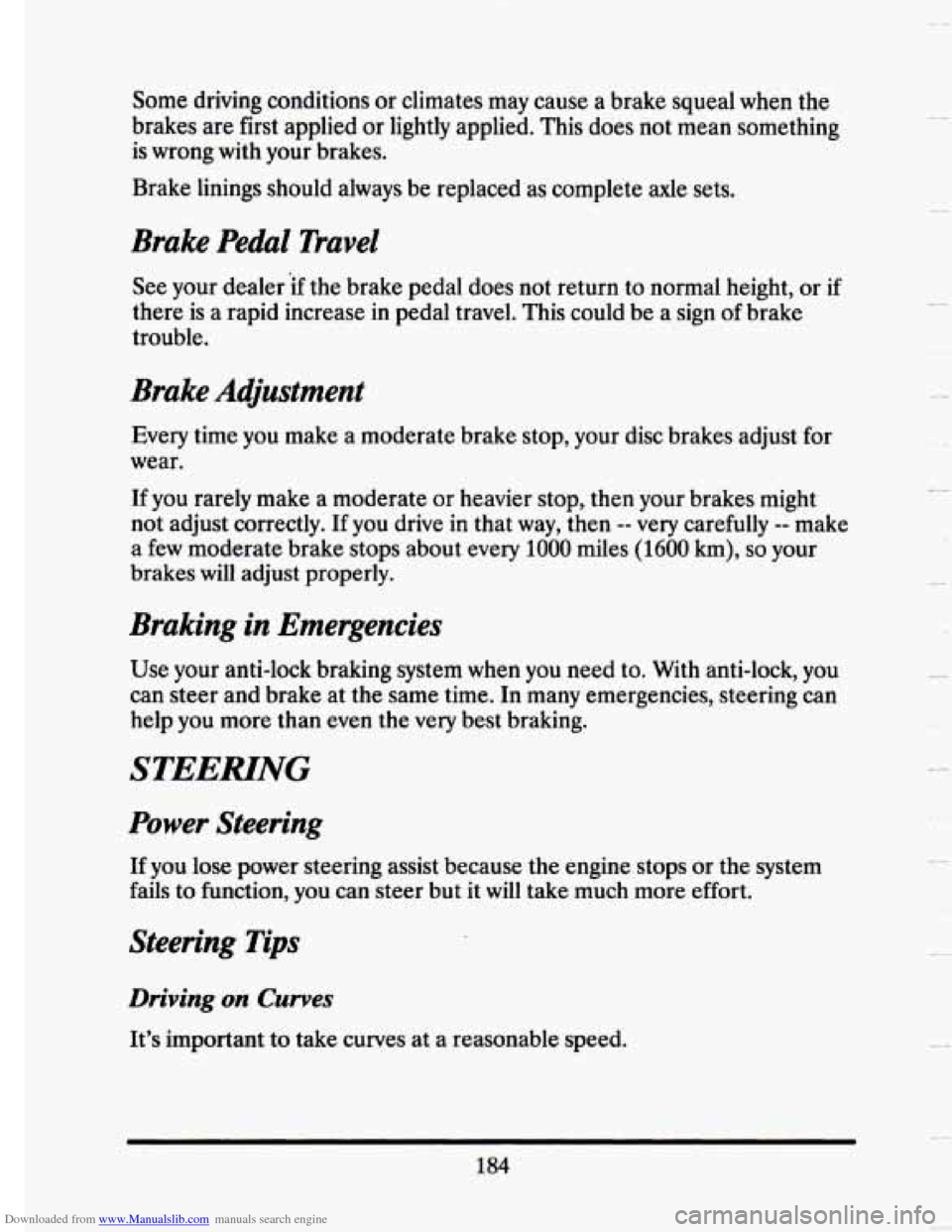
Downloaded from www.Manualslib.com manuals search engine Some driving conditions or climates may cause a brake squeal when the
brakes are first applied or lightly applied. This does not mean something
is wrong with your brakes.
Brake linings should always be replaced as complete axle sets. \
Brake Pedal Travel
See your dealer if the brake pedal does not return to normal height, or if
there is a rapid increase in pedal travel. This could be a sign of brake
trouble.
Brake Agustment
Every time you make a moderate brake stop, your disc brakes adjust for
wear.
If you rarely make a moderate or heavier stop, then your brakes might
not adjust correctly. If you drive
in that way, then -- very carefully -- make
a few moderate brake stops about every
1000 miles (1600 km), so your
brakes will adjust properly.
Braking in Emergencies
Use your anti-lock braking system when you need to. With anti-lock, you
can steer and brake at
the same time. In many emergencies, steering can
help you more than even the
very best braking.
STEERING
Power Steering
If you lose power steering assist because the engine stops or the system
fails to function, you can steer but it
will take much more effort.
Steering Tips
Driving on Curves
It’s important to take curves at a reasonable speed.
184
c
c
u
Page 199 of 407

Downloaded from www.Manualslib.com manuals search engine A lot of the “driver lost control” accidents mentioned on the news
happen on curves. Here’s
why:
Experienced driver or beginner, each of us is subject to the same laws of
physics when driving on curves. The traction of the tires against the road
surface makes it possible for the vehicle to change its path
when you turn
the front wheels.
If there’s no traction, inertia will keep the vehicle going
in the same direction. If you’ve ever tried to steer a vehicle on wet ice,
you’ll understand this.
The traction
you can get in a curve depends on the condition of your tires
and the road surface, the angle at which the curve is banked, and your
speed. While you’re in a curve, speed is the one factor you can control.
Suppose you’re steering through a sharp curve. Then you suddenly
accelerate.
Those
two control systems -- steering and acceleration -- can overwhelm
those places where the tires meet the road and make you lose control.
What should you do
if this ever happens? Let up on the accelerator
pedal, steer the vehicle the
way you want it to go, and slow down.
Speed
limit signs near curves warn that you should adjust your speed. Of
course, the posted speeds are based on good weather and road
conditions. Under less favorable conditions you’ll want to
go slower.
If you need to reduce your speed as you approach a curve, do it before
you enter the curve, while your front wheels are straight ahead.
Try to adjust your speed so you can “drive” through the curve. Maintain a
reasonable, steady speed. Wait to accelerate
until you are out of the
curve, and then accelerate gently into the straightaway.
When you drive into a curve at night, it’s harder to see the road ahead of
you because
it bends away from the straight beams of your lights. This is
one good reason to drive slower.
Steering in Emergencies
There are times when steering can be more effective than braking. For
example, you come over a
hill and find a truck stopped in your lane, or a
car suddenly pulls out from nowhere,
or a child darts out from between
parked cars and stops right
in front of you. You can avoid these problems
185
Page 200 of 407

Downloaded from www.Manualslib.com manuals search engine by braking -- if you can stop in time. But sometimes you can’t; there isn’t
room. That’s the time for evasive action
-- steering around the problem.
Your Cadillac can perform
very well in emergencies like these. First apply
your brakes. It is better to remove as much speed as
you can from a
possible collision.
Then steer around the problem, to the left or right
depending
on the space available.
An emergency like this requires close attention and a quick decision. If
you are holding the steering wheel at the recommended 9 and 3 o’clock
positions, you can turn
it a full 180 degrees very quickly without removing
either hand. But
you have to act fast, steer quickly, and just as quickly
straighten the wheel once you have avoided the object. You must then be
prepared to steer back to your original lane and then brake to a
controlled stop.
Depending
on your speed, this can be rather violent for an unprepared
driver. This
is one of the reasons driving experts recommend that you use
your safety belts and keep both hands
on the steering wheel.
I
The fact that such emergency situations are always possible is a good
reason to practice defensive driving at all times.
OFF-ROAD RECOKERY
You may find sometime that your right wheels have dropped off the edge
of a road onto the shoulder while you’re driving.
186
.I